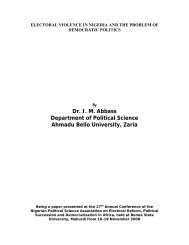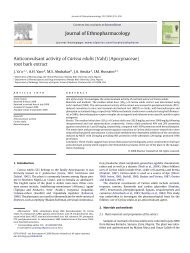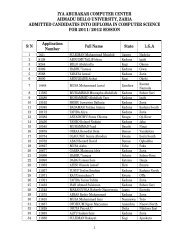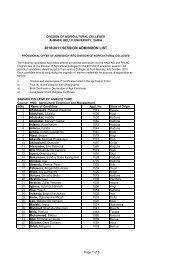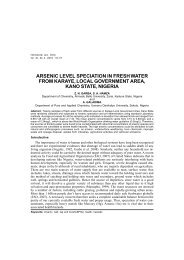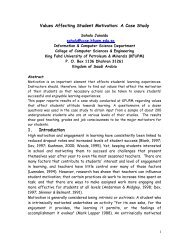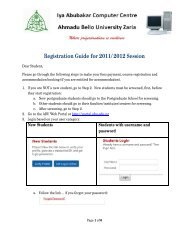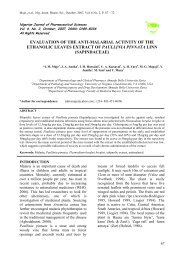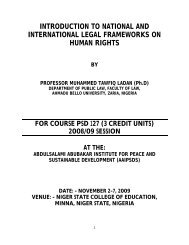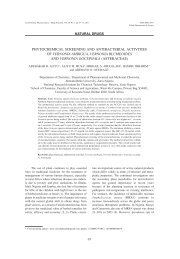Analgesic and anti-inflammatory studies of the methanol
Analgesic and anti-inflammatory studies of the methanol
Analgesic and anti-inflammatory studies of the methanol
You also want an ePaper? Increase the reach of your titles
YUMPU automatically turns print PDFs into web optimized ePapers that Google loves.
Research Journal <strong>of</strong> Medicine <strong>and</strong> Medical Sciences, 5(1): 106-110, 2010<br />
© 2010, INSInet Publication<br />
<strong>Analgesic</strong> <strong>and</strong> Anti-<strong>inflammatory</strong> Studies <strong>of</strong> <strong>the</strong> Methanol Extract <strong>of</strong> Indig<strong>of</strong>era Pulchra<br />
1 Musa, A.M., 1 Sule, M.I., 1 Ilyas, M., 1 Iliya I. 2 Yaro, A.H., 3 Magaji, M.G. 4 Aliyu, A.B.<br />
1 Adbullahi, M.I. <strong>and</strong> 1 Hassan, H.S.<br />
1 Department <strong>of</strong> Pharmaceutical <strong>and</strong> Medicinal Chemistry Ahmadu Bello University, Zaria, Nigeria.<br />
2 Department <strong>of</strong> Pharmacology, Bayero University, Kano, Nigeria.<br />
3 Department <strong>of</strong> Pharmacology <strong>and</strong> Therapeutics Ahmadu Bello University, Zaria, Nigeria.<br />
4 Department <strong>of</strong> Chemistry Ahmadu Bello University, Zaria, Nigeria.<br />
Abstract: The <strong>methanol</strong> extract <strong>of</strong> <strong>the</strong> aerial parts <strong>of</strong> Indig<strong>of</strong>era pulchra was evaluated for its analgesic<br />
<strong>and</strong> <strong>anti</strong>-<strong>inflammatory</strong> activities. The analgesic effect was studied using acetic acid-induced abdominal<br />
constriction <strong>and</strong> hot plate tests in mice, while <strong>the</strong> <strong>anti</strong>-<strong>inflammatory</strong> effect was investigated using<br />
carrageenan- induced paw oedema in rats. The results <strong>of</strong> <strong>the</strong> study showed that <strong>the</strong> extract at all doses<br />
tested (50-200mg/Kg) exhibited significant (P
Extraction: The powdered plant material (500 g) was<br />
extracted with <strong>methanol</strong> (2L) using soxhlets apparatus,<br />
<strong>the</strong> solvent was removed in-vacuo to yield a residue<br />
(56 g) subsequently referred to as Indig<strong>of</strong>era pulchra<br />
extract .The extract was kept in a dessicator <strong>and</strong> a<br />
fresh solution in distil water was prepared for each<br />
experiment.<br />
Chromatographic analyses <strong>of</strong> <strong>the</strong> <strong>methanol</strong> extract:<br />
The chromatographic analysis was done by thin layer<br />
chromatography (TLC) (silica gel on aluminium<br />
plates).The <strong>methanol</strong> extract was spotted on to <strong>the</strong> TLC<br />
plates <strong>and</strong> developed using three solvent system with<br />
different polarities i.e. hexane/ethylacetate<br />
(5:1),chlor<strong>of</strong>orm/<strong>methanol</strong>(19:1), <strong>and</strong> ethylacetate:<br />
chlor<strong>of</strong>orm: <strong>methanol</strong> :water(15:8:4:1). The separated<br />
components were visualized under visible <strong>and</strong> U.V.<br />
light (254 <strong>and</strong> 366 nm) <strong>and</strong> sprayed with <strong>the</strong> following<br />
reagents in order to reveal <strong>the</strong> spots <strong>of</strong> different<br />
phytochemical groups: Dragend<strong>of</strong>f’s reagent for<br />
alkaloids, 10% potassium hydroxide solution in<br />
<strong>methanol</strong> for anthraquinones <strong>and</strong> coumarins ,<br />
aluminium chloride for flavonoids <strong>and</strong> anisaldehyde<br />
/sulphuric acid for steroid, terpenes, phenanthrenes <strong>and</strong><br />
dihydrostilbene nucleus [16] .<br />
Animals: Adult Swiss albino mice <strong>of</strong> ei<strong>the</strong>r sex<br />
weighing between 19-22g <strong>and</strong> rats weighing 150-200g<br />
obtained from <strong>the</strong> animal house facility, Department <strong>of</strong><br />
Pharmacology <strong>and</strong> Therapeutics, Ahmadu Bello<br />
University, Zaria-Nigeria were used for <strong>the</strong>se <strong>studies</strong>.<br />
The animals were housed in a st<strong>and</strong>ard cage at room<br />
temperature in a 12/12 hour light <strong>and</strong> dark cycle, <strong>and</strong><br />
were supplied with food <strong>and</strong> water ad libitum. All<br />
experiments were conducted in accordance with animal<br />
use ethics as accepted internationally.<br />
Drug: Ketopr<strong>of</strong>en injection (Lek pharmaceuticals<br />
company, Slovenia) <strong>and</strong> morphine (Martindale, Essex)<br />
were used as st<strong>and</strong>ard drugs.<br />
Route <strong>of</strong> Administration: The extract <strong>and</strong> <strong>the</strong> st<strong>and</strong>ard<br />
drugs were administered to <strong>the</strong> animals intraperitoneally<br />
in all <strong>the</strong> experiments.<br />
Acute toxicity study: The study was divided into two<br />
phases. In <strong>the</strong> first phase, nine mice <strong>of</strong> ei<strong>the</strong>r sex<br />
were divided into three groups <strong>of</strong> three mice each.<br />
Group I received 10 mg/Kg extract while group II <strong>and</strong><br />
III received 100 <strong>and</strong> 1000 mg/kg extract respectively.<br />
The mice were observed for signs <strong>and</strong> symptoms <strong>of</strong><br />
toxicity <strong>and</strong> mortality for twenty four hours after<br />
treatment. In <strong>the</strong> second phase, 3 mice were divided<br />
into 3 groups <strong>of</strong> one mouse each <strong>and</strong> treated based on<br />
<strong>the</strong> result <strong>of</strong> <strong>the</strong> first phase. The first received extract<br />
Res. J. Medicine & Med. Sci., 5(1): 106-110, 2010<br />
107<br />
at a dose <strong>of</strong> 1600 mg/kg, while <strong>the</strong> second <strong>and</strong> third<br />
groups received <strong>the</strong> extract at doses <strong>of</strong> 2900 <strong>and</strong> 5000<br />
mg/Kg respectively. The mice were also observed for<br />
24 hours. The final LD 50 was calculated as <strong>the</strong> square<br />
root <strong>of</strong> <strong>the</strong> product <strong>of</strong> <strong>the</strong> lowest lethal dose <strong>and</strong> <strong>the</strong><br />
highest non-lethal dose i.e. <strong>the</strong> geometric mean <strong>of</strong><br />
consecutive doses for which 0 <strong>and</strong> 100% survival rates<br />
were recorded [17] .<br />
Acetic acid – induced abdominal constrictions in<br />
mice: Twenty five albino mice were divided into five<br />
groups <strong>of</strong> five mice each. Group I was injected with<br />
10 ml/Kg <strong>of</strong> normal saline (negative control). Group II<br />
was injected with ketopr<strong>of</strong>en 10mg/kg (positive<br />
control). Groups III, IV <strong>and</strong> V were injected with 50,<br />
100 <strong>and</strong> 200 mg/Kg <strong>of</strong> <strong>the</strong> extract respectively. Thirty<br />
minutes later, each mouse was injected with 10ml/kg<br />
<strong>of</strong> aqueous solution <strong>of</strong> acetic acid (0.6%)<br />
intraperitoneally. The number <strong>of</strong> abdominal<br />
constrictions for each mouse was counted five minutes<br />
after injection <strong>of</strong> acetic acid for a period <strong>of</strong> ten minutes<br />
with a tally counter [18] . The percentage inhibition <strong>of</strong><br />
abdominal constrictions was calculated using <strong>the</strong><br />
following formula:<br />
Inhibition (%) = Mean No. <strong>of</strong> wri<strong>the</strong>s (Control) –<br />
Mean No. <strong>of</strong> wri<strong>the</strong>s (test) x 100<br />
Mean No. <strong>of</strong> wri<strong>the</strong>s (Control)<br />
Hot plate test method: Mice were placed on a hot<br />
plate maintained at temperature <strong>of</strong> 50±0.5 0 C. The time<br />
taken for ei<strong>the</strong>r paw licking or jumping (pain reaction<br />
time) by each mouse was recorded. Mice that showed<br />
initial nociceptive response within 20 seconds were<br />
selected <strong>and</strong> used for <strong>the</strong> study. The mice were <strong>the</strong>n<br />
divided into 5 groups each containing 5 mice. Group<br />
I served as negative control <strong>and</strong> received 10ml/Kg<br />
normal saline while groups II, III <strong>and</strong> IV received <strong>the</strong><br />
extract (i.p) at doses <strong>of</strong> 50,100 <strong>and</strong> 200mg/Kg<br />
respectively <strong>and</strong> <strong>the</strong> last group received morphine<br />
(5mg/Kg). Thirty minutes later each mouse was placed<br />
on a hot plate <strong>and</strong> <strong>the</strong> pain reaction time recorded [19] .<br />
Carrageenan-induced Paw Oedema in Rats: Twenty<br />
five mice were divided into 5 groups <strong>of</strong> 5 mice each.<br />
Group I received 10ml/Kg normal saline group II<br />
received ketopr<strong>of</strong>en 10mg/Kg (Positive control), while<br />
groups III, IV <strong>and</strong> V received extract at doses <strong>of</strong> 50,<br />
100 <strong>and</strong> 200 mg/Kg respectively. Thirty minutes later,<br />
0.1ml <strong>of</strong> sterile saline suspension <strong>of</strong> 1% w/v<br />
carrageenan was injected into <strong>the</strong> subplantar surface <strong>of</strong><br />
<strong>the</strong> left hind paw. Paw size was measured using vernier<br />
caliper at time 0, 1, 2, 3, 4 <strong>and</strong> 5 hours after <strong>the</strong><br />
carrageenan administration [20] .
Statistical analysis: All data were expressed as mean<br />
± S.E.M. The mean values <strong>of</strong> control groups were<br />
compared with <strong>the</strong> mean value <strong>of</strong> treated groups using<br />
student ’ s t-test. Results were considered significant at<br />
P
Res. J. Medicine & Med. Sci., 5(1): 106-110, 2010<br />
Table 3: Percentage inhibition expressed by <strong>methanol</strong> extract <strong>and</strong> ketopr<strong>of</strong>en on carrageenan induced oedema in rats.<br />
Treatment Dose % INHIBITION AT VARIOUS TIME Mean % inhibition<br />
-------------------------------------------------------------------------------------------<br />
1h 2h 3h 4h 5h<br />
Normal Saline 10ml/Kg - - - - - -<br />
----------------------------------------------------------------------------------------------------------------------------------------------------------------------------------------<br />
Extract 50mg/Kg 63.6 52.2 69 61.4 80.7 64.4<br />
----------------------------------------------------------------------------------------------------------------------------------------------------------------------------------------<br />
Extract 100mg/Kg 51.7 59.7 72.2 56.6 72 62.4<br />
----------------------------------------------------------------------------------------------------------------------------------------------------------------------------------------<br />
Extract 200mg/Kg 70.3 72.6 68 70 78.6 71.9<br />
----------------------------------------------------------------------------------------------------------------------------------------------------------------------------------------<br />
Ketopr<strong>of</strong>en 10mg/Kg 46.6 51.2 66.2 44.1 41.8 50<br />
Table 4: Effect <strong>of</strong> <strong>the</strong> <strong>methanol</strong> extract <strong>of</strong> I. pulchra on carrageenan- induced paw oedema in rats.<br />
Treatment Dose Mean Paw Oedema Diametre± SEM (cm)<br />
----------------------------------------------------------------------------------------------------------------------------<br />
1h 2 h 3 h 4h 5h<br />
Normal saline 10ml/Kg 0.236±0.146 0.402±0.001 0.438±0.188 0.290±0.290 0.364±0.037<br />
----------------------------------------------------------------------------------------------------------------------------------------------------------------------------------------<br />
Extract 50mg/Kg 0.086±0.021 b 0.192±0.022 b 0.136±0.018 b 0.112±0.011 b 0.07±0.020 b<br />
----------------------------------------------------------------------------------------------------------------------------------------------------------------------------------------<br />
Extract 100mg/Kg 0.114±0.017 b 0.162±0.036 b 0.122±0.023 b 0.126±0.035 b 0.102±0.017 b<br />
----------------------------------------------------------------------------------------------------------------------------------------------------------------------------------------<br />
Extract 200mg/Kg 0.07±0.014 b 0.11±0.038 b 0.14±0.035 b 0.086±0.019 b 0.078±0.026 b<br />
----------------------------------------------------------------------------------------------------------------------------------------------------------------------------------------<br />
Ketopr<strong>of</strong>en 10mg/Kg 0.126±0.010 b 0.196±0.007 b 0.148±0.021 b 0.162±0.021 b 0.212±0.020 b<br />
a P
6. Burkill , H.M., 1995. The Useful Plants <strong>of</strong> West<br />
Tropical Africa. Royal Botanic garden Kew (UK),<br />
3: 361-670.<br />
7. Sule , M.I., U.U. Pateh, A.K. Haruna, M. Garba,<br />
A.A. Ahmadu, A.K. Adamu, 2003. Plants used in<br />
Hausa traditional medicine in Nor<strong>the</strong>rn Nigeria. J.<br />
Trop. Bio., 3: 17-20.<br />
8. Abubakar, M.S., A.M. Musa, A. Ahmed, I.M.<br />
Husaini, 2007. The perception <strong>and</strong> practice <strong>of</strong><br />
traditional medicine in <strong>the</strong> treatment <strong>of</strong> cancers <strong>and</strong><br />
inflammations by <strong>the</strong> Hausa <strong>and</strong> Fulani tribes <strong>of</strong><br />
Nor<strong>the</strong>rn Nigeria. J. Ethnopharmacol, 111(3): 625-<br />
629.<br />
9. Cola-mirinda, M., V. Barbestafano, A.C. Hiruma-<br />
Lima, R.T. Calvo, W. Villegas, A.M. SouzaBritto,<br />
2006. Anti-ulcerogenic activity <strong>of</strong> Indig<strong>of</strong>era<br />
truxellensis (Kunth). Biotaneotropica, 6(3)http://www.biotanotropica.org.br/V6n3<br />
10. Adamu, H.M., O.J. Abayeh, M.O. Agbo, A.L.<br />
Abdullahi, A. Uba, H.U. Dukku, B.M. Wufem,<br />
2005. An ethnobotanical survey <strong>of</strong> Bauchi State<br />
herbal plants <strong>and</strong> <strong>the</strong>ir <strong>anti</strong>microbial activity. J.<br />
Ethnopharmacol, 99: 1-4.<br />
11. Asase, A., A.A. Oteng-Yeboah, G.T. Odamtten,<br />
2005. Simmonds MSJ. Ethnobotanical study <strong>of</strong><br />
some Ghanaian <strong>anti</strong>-malarial plants. J.<br />
Ethnopharmacol, 99: 273-279.<br />
12. Abubakar, M.S., E. Balogun, E.M. Abdurrahman,<br />
A.J. Nok, M. Shok, A. Mohammed, M. Garba,<br />
2006. Ethnomedical treatment <strong>of</strong> poisonous<br />
snakebites: Plant extract neutralized Naja<br />
nigricollis venom. Pharm Biol., 44(5): 343-348.<br />
13. Musa, A.M., A.K. Haruna, M. Ilyas, I. Iliya, I.N.<br />
Akpulu, 2007. Phytochemical <strong>and</strong> <strong>anti</strong>microbial<br />
<strong>studies</strong> <strong>of</strong> Indig<strong>of</strong>era pulchra. Int Jour <strong>of</strong> Pure<br />
Appl Sci., 1(3): 25-30.<br />
14. Musa, A.M., A.K. Haruna, M. Ilyas, A. Ahmadu,<br />
S. Gibbons, M. Mukhlesur Rahman, 2008.<br />
Dihydrostilbenes from Indig<strong>of</strong>era pulchra. Nat.<br />
Prod. Comm, 3(5): 805-808<br />
15. Musa, A.M., M.I. Sule, A.K. Haruna, M. Ilyas, I.<br />
Iliya, A.H. Yaro, M.G. Magaji, 2008. Preliminary<br />
gastrointestinal <strong>studies</strong> <strong>of</strong> <strong>the</strong> <strong>methanol</strong> extract <strong>of</strong><br />
Indig<strong>of</strong>era pulchra Willd in Rodents. Nig. J.<br />
Pharm Sci., 7(1): 33-39.<br />
16. Krebs, K.G., D. Heusser, H. Wimmer, 1969. In<br />
Spray Reagents in Thin Layer Chromatography<br />
Laboratory H<strong>and</strong>book . Stahl,E. (ed), pp: 65-76.<br />
Res. J. Medicine & Med. Sci., 5(1): 106-110, 2010<br />
110<br />
17. Lorke, D., 1983. A New Approach to practical<br />
acute toxicity testing. Arch. Toxicol, 54: 275 -<br />
287.<br />
18. Koster, R., M. Anderson, E.J. DeeBeer, 1959.<br />
Acetic acid for analgesic screening. Fed Proc, 18:<br />
412.<br />
19. Turner, R.A., 1965. <strong>Analgesic</strong>s. In: Turner R A.<br />
(ed), Screening Methods in Pharmacology.<br />
Academic Press, London, U.K., pp: 100.<br />
20. Winter, E.A., E.A. Risley, G.B. Nuss, 1963. Anti<strong>inflammatory</strong><br />
<strong>and</strong> <strong>anti</strong>pyretic activities <strong>of</strong><br />
indomethacin. J. Pharmacol Exp. Therap., 141:<br />
369-376.<br />
21. Gene, R.M., L. Segurzas, T. Adzet, E. Marin, J.<br />
Inglesias, 1998. Hetero<strong>the</strong>ca inuloides: Anti<strong>inflammatory</strong><br />
<strong>and</strong> analgesic effects. J.<br />
Ethnopharmacol, 60: 157-162.<br />
22. Bentley, G.A., S.H. Newton, J. Starr,1983. Studies<br />
on <strong>the</strong> <strong>anti</strong>-nociceptive action <strong>of</strong> agonist drugs <strong>and</strong><br />
<strong>the</strong>ir interaction with opiod mechanisms. Brit. J.<br />
Pharmacol., 32: 295-310.<br />
23. Deradt, R., S. Jougney, F. Delevalcee, M.<br />
Falhout, 1980. Release <strong>of</strong> prostagl<strong>and</strong>in E <strong>and</strong> F in<br />
an algogenic reaction <strong>and</strong> its inhibition. Eur. J.<br />
Pharmacol., 51: 17-24.<br />
24. Levini, J.D., W. Lau, G. Kwait, E.J. Goetzl,<br />
1984. Leukotriene B4 produces hyperalgesia that is<br />
dependent on <strong>the</strong> polymorph-nuclear leucocytes.<br />
Sci., 225: 743-745.<br />
25. Parkhouse, J., B.J. Pleuvry, 1979. <strong>Analgesic</strong> drugs.<br />
Blackwell Co. Oxford., pp: 1.<br />
26. Brito, A.R.M.S., M.A. Antonio, 1988. Oral <strong>anti</strong><strong>inflammatory</strong><br />
<strong>and</strong> <strong>anti</strong>-ulcerogenic activities <strong>of</strong> a<br />
hydroalcoholic extract <strong>and</strong> partition fraction <strong>of</strong><br />
Turnera ulmifolia (Turneaceae). J Ethnopharmacol.,<br />
61: 215-228.<br />
27. Just, M.J., M.C. Recio, R.M. Geiner, M.J. Cullar,<br />
S. Manez, A.R. Billie,1998. Anti-<strong>inflammatory</strong><br />
activity <strong>of</strong> unusual lupane saponins from<br />
Buphleurum frutiscescens. Plant Med., 64: 404-<br />
407.<br />
28. Das, P.C., A. Das, S. M<strong>and</strong>al,1989. Antimicrobial<br />
<strong>and</strong> <strong>anti</strong>-<strong>inflammatory</strong> activities <strong>of</strong> <strong>the</strong> seed kernel<br />
<strong>of</strong> Mangifera indica. Fitoterapia, 60: 235-240.<br />
29. Choi, J., H. Jung, K. Lee, H. Park, 2005.<br />
Antinociceptive <strong>and</strong> <strong>anti</strong>-<strong>inflammatory</strong> effects <strong>of</strong><br />
saponin <strong>and</strong> sapogenin obtained from <strong>the</strong> stem <strong>of</strong><br />
Akebia quinata J. Med. Food, 8(1): 78-85.


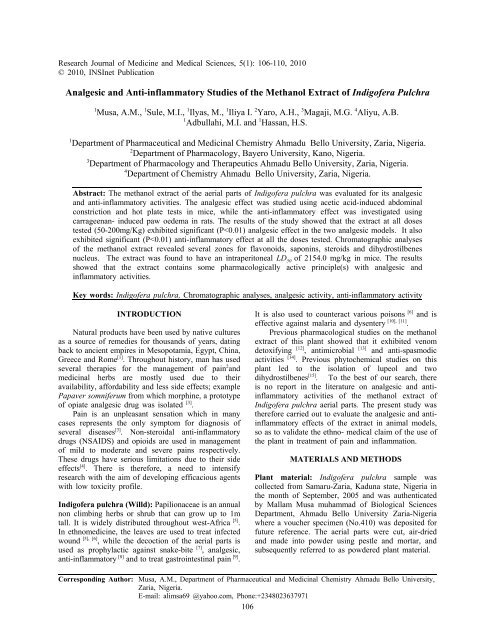
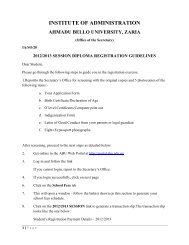
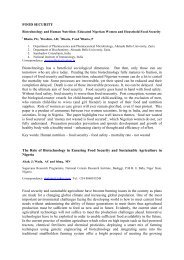
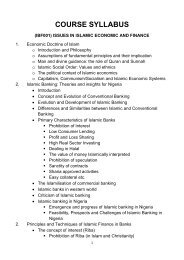
![Full Paper [PDF]](https://img.yumpu.com/49740055/1/184x260/full-paper-pdf.jpg?quality=85)
